5 Best Anti Bark Shock Collar In 2025
Excessive barking can strain relationships with neighbors and create stress for both pets and owners. Anti bark shock collars offer an effective solution to control unwanted barking behavior in dogs of all sizes. These devices use various training methods including beeps, vibrations, and mild electrical stimulation to discourage persistent barking.
Modern bark collars have evolved significantly from their early designs. Today’s smart collars incorporate advanced technology that detects genuine barks while ignoring other sounds. They feature multiple training modes, adjustable sensitivity levels, and waterproof construction for outdoor use.
This comprehensive review examines the top five anti bark shock collars available today. Each product offers unique features designed to address different training needs and dog sizes. The evaluation covers effectiveness, safety features, ease of use, and value for money.
How Anti Bark Shock Collars Work
Anti bark shock collars detect barking through vibration sensors or sound recognition technology. When the device identifies a bark, it delivers a corrective stimulus to interrupt the behavior. Most collars start with gentle warnings like beeps or vibrations before escalating to mild electrical stimulation.
The electrical stimulation used in modern bark collars is safe and humane. These devices produce a mild static sensation similar to touching a doorknob after walking on carpet. The intensity remains well below levels that could cause harm or injury to your pet.
Smart technology in today’s collars prevents false triggers from external noises. The devices distinguish between your dog’s bark and other sounds like car horns, children playing, or other dogs barking nearby. This precision ensures your dog receives correction only for their own barking behavior.
Progressive training modes start with the gentlest correction and increase intensity only if barking continues. Many collars automatically reset to the lowest level after a period without barking, preventing over-correction and maintaining effectiveness over time.
Key Features to Consider
Sensitivity Adjustment The ability to adjust sensitivity levels allows customization for different dog breeds and barking intensities. Sensitive dogs may respond to lower settings, while stubborn barkers might require higher levels. Look for collars with at least five adjustable sensitivity levels.
Multiple Training Modes Effective bark collars offer various correction methods including sound, vibration, and electrical stimulation. Some dogs respond better to certain types of correction. Having multiple options allows you to find the most effective approach for your pet.
Battery Life and Charging Long battery life reduces maintenance and ensures consistent operation. Rechargeable collars with quick-charge capabilities provide convenience and reliability. Look for devices that offer at least one week of operation per charge.
Waterproof Construction Dogs need protection from weather conditions during outdoor activities. IPX7 or IP67 rated collars can withstand rain, swimming, and wet conditions without compromising functionality.
Size and Weight The collar should be appropriate for your dog’s size and weight. Heavy collars can cause discomfort for small dogs, while collars that are too small may not be effective on larger breeds.
Product Reviews: Top 5 Anti Bark Shock Collars
1. 2-in-1 Dog Shock Collar & Dog Bark Collar – Smart Anti Barking Training Device
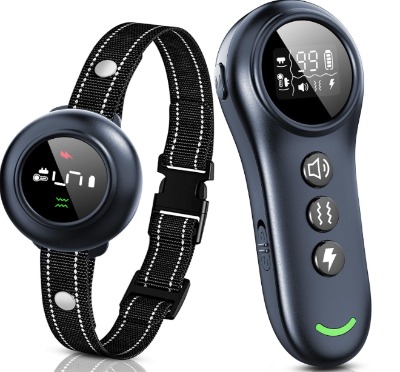
This versatile collar combines remote training capabilities with automatic bark detection in a single device. The dual functionality makes it ideal for comprehensive dog training beyond just bark control.
Key Features:
- 3300-foot remote range for training at distance
- Five adjustable sensitivity levels
- IP67 waterproof rating
- Suitable for all dog breeds
- Rechargeable battery with extended life
The remote training feature allows owners to deliver corrections for various behavioral issues including excessive barking, jumping, and pulling. The long-range capability makes it perfect for off-leash training in large yards or open spaces.
The automatic bark detection system uses advanced algorithms to identify genuine barks and ignore false triggers. The five sensitivity levels provide precise control over correction intensity, allowing customization for different dogs and situations.
Construction quality impresses with its IP67 waterproof rating that protects against complete water submersion. The collar withstands rain, snow, and even swimming activities without compromising performance.
The rechargeable battery provides up to two weeks of operation with regular use. Quick-charge technology delivers a full charge in just two hours, minimizing downtime during training.
Pros:
- Dual remote and automatic functionality
- Excellent range for outdoor training
- Superior waterproof protection
- Long battery life
- Works with all dog sizes
Cons:
- Higher price point than single-function collars
- May be complex for basic bark control needs
- Remote adds extra component to manage
2. Smart Dog Bark Collar for Dogs 10-100lbs
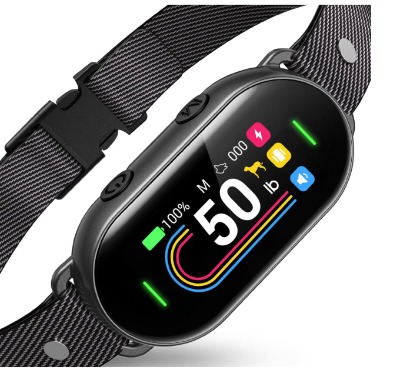
Designed specifically for medium to large dogs, this collar provides robust bark control with intelligent detection technology. The wide weight range makes it suitable for most adult dogs.
Key Features:
- Four distinct training modes
- Eight sensitivity levels for precise control
- Automatic bark detection system
- Suitable for dogs weighing 10-100 pounds
- Rechargeable battery with indicator
The four training modes include beep only, vibration only, shock only, and progressive mode that escalates through all three. This variety allows owners to find the most effective correction method for their specific dog.
Eight sensitivity levels provide fine-tuned control over detection and correction intensity. The system learns your dog’s barking patterns and adjusts accordingly to prevent over-correction or under-correction.
The automatic system activates only when it detects genuine barking from the wearing dog. Advanced sound filtering prevents activation from other dogs, environmental noises, or false triggers.
Battery life extends up to 15 days with normal use. The LED indicator shows battery status and charging progress, preventing unexpected power loss during training periods.
Pros:
- Excellent for medium to large dogs
- Multiple training modes offer versatility
- Eight sensitivity levels provide precision
- Long battery life reduces maintenance
- Smart detection prevents false triggers
Cons:
- Not suitable for small dogs under 10 pounds
- Limited color options
- May require adjustment period for optimal settings
3. Smart AI Bark Collar for Dogs 5-15lbs and Larger Breeds
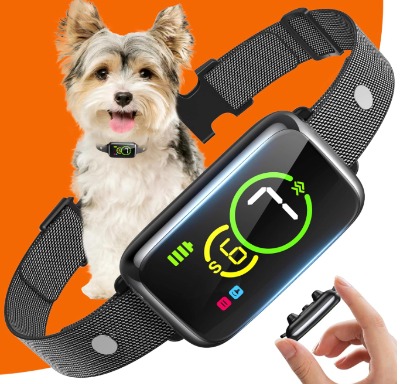
This innovative collar uses artificial intelligence to distinguish between different types of barking and environmental sounds. The AI technology represents the cutting edge of bark control technology.
Key Features:
- AI-powered bark recognition
- Suitable for dogs from 5 pounds and up
- Adjustable beep and vibration modes
- Seven sensitivity levels
- Automatic anti-barking system
The AI bark recognition system analyzes sound patterns, frequency, and duration to identify genuine barking behavior. This technology virtually eliminates false activations while ensuring consistent correction for problem barking.
The collar accommodates an unusually wide range of dog sizes, from tiny breeds weighing just five pounds to large dogs over 100 pounds. The lightweight design ensures comfort for small dogs while providing effective correction for larger breeds.
Beep and vibration modes can be adjusted independently, allowing owners to customize the correction sequence. Some dogs respond better to sound warnings, while others require physical sensation to interrupt barking behavior.
Seven sensitivity levels enable precise calibration for different barking intensities and dog temperaments. The system automatically adjusts over time based on your dog’s response patterns.
Pros:
- Advanced AI prevents false triggers
- Suitable for extremely wide weight range
- Lightweight design for small dogs
- Independent mode adjustment
- Self-learning system improves over time
Cons:
- Premium price for AI technology
- May require initial setup time
- Battery life shorter than some competitors
4. 2-Pack Smart Bark Collar Set
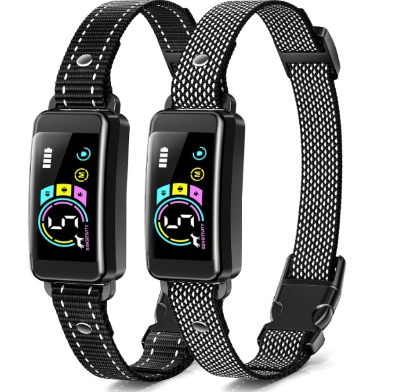
This value package provides two identical bark collars at a reduced per-unit cost. The set is perfect for multi-dog households or owners who want a backup collar.
Key Features:
- Two complete collar systems
- Suitable for small, medium, and large dogs
- Beep, vibration, and shock modes
- Five adjustable sensitivity levels
- Harmless shock technology
Each collar in the set includes complete functionality with beep warnings, vibration alerts, and safe electrical stimulation. The identical design ensures consistent training across multiple dogs.
The harmless shock technology delivers mild static stimulation that interrupts barking without causing pain or distress. The sensation is comparable to static electricity from synthetic fabrics.
Five sensitivity levels allow customization for different dog personalities and barking habits. The progressive correction system starts gentle and increases intensity only when necessary.
The value proposition excels for households with multiple dogs or owners who want redundancy. Having two collars ensures continuous training even during charging or maintenance of one unit.
Pros:
- Excellent value for two complete systems
- Consistent training for multiple dogs
- Harmless correction technology
- Good sensitivity range
- Backup collar availability
Cons:
- Basic feature set compared to premium models
- Limited battery life indicators
- Fewer training mode options
5. DINJOO Rechargeable Smart Bark Collar
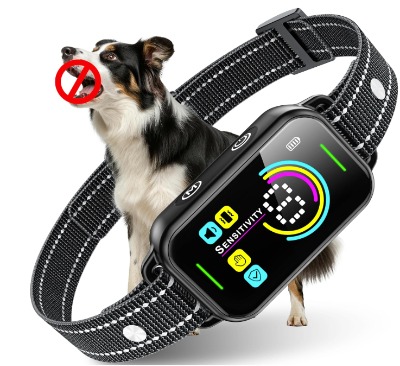
This budget-friendly option provides essential bark control features with reliable performance. The collar offers good value for owners seeking basic anti-barking functionality.
Key Features:
- Eight adjustable sensitivity levels
- Rechargeable battery system
- Smart bark detection technology
- Beep and shock correction modes
- Suitable for small, medium, and large dogs
Eight sensitivity levels provide more adjustment options than many competitors at this price point. The range accommodates everything from gentle dogs who respond to low settings to persistent barkers requiring higher correction levels.
The rechargeable battery eliminates ongoing costs for replacement batteries while providing reliable operation. The charging system is simple and straightforward with clear indicators.
Smart detection technology filters out most false triggers while maintaining responsiveness to genuine barking. The system works well for typical household environments and outdoor use.
Beep and shock modes offer two distinct correction methods. The beep warning often stops barking before electrical stimulation becomes necessary, making training more pleasant for both dog and owner.
Pros:
- Affordable price point
- Eight sensitivity levels
- Rechargeable convenience
- Simple operation
- Good build quality for the price
Cons:
- Limited training modes
- Basic detection technology
- Shorter battery life than premium models
- Minimal waterproof protection
Installation and Setup Guide
Proper installation ensures maximum effectiveness and lmfort. Start by measuring your dog’s neck to select the correct collar size. The collar should fit snugly but not tight, with space for one finger between the strap and neck.
Position the contact points against your dog’s throat area where barking vibrations are strongest. The sensors and stimulation contacts must maintain consistent contact with the skin for reliable operation.
Charge the collar completely before first use. Most devices require 2-4 hours for full charge and should be charged regularly to maintain battery health and consistent performance.
Begin with the lowest sensitivity setting and observe your dog’s response over several days. Increase sensitivity gradually if barking continues, but avoid jumping to high levels immediately.
Test the collar’s detection by encouraging controlled barking in a safe environment. Verify that the device activates appropriately and that other sounds don’t trigger false corrections.
Training Tips for Maximum Effectiveness
Consistency remains crucial for successful bark training. Use the collar every time your dog exhibits unwanted barking behavior to establish clear associations between action and consequence.
Combine collar training with positive reinforcement techniques. Reward quiet behavior with treats, praise, and attention to reinforce desired responses alongside correction of unwanted behavior.
Start training sessions in controlled environments before moving to challenging situations. Allow your dog to understand the collar’s function in familiar settings before encountering triggers like visitors or other dogs.
Monitor your dog’s stress levels during initial training periods. Some dogs may show anxiety or confusion as they learn the new system. Reduce sensitivity or take breaks if stress levels become excessive.
Remove the collar during non-training periods to prevent skin irritation and allow your dog to relax. Continuous wear can cause discomfort and may reduce the collar’s effectiveness over time.
Safety Considerations and Best Practices
Modern bark collars incorporate multiple safety features to protect your dog’s wellbeing. Automatic shutoff functions prevent continuous stimulation if the device malfunctions or becomes stuck in activation mode.
Rotation schedules prevent skin irritation from constant contact with correction points. Move the collar slightly each day and inspect your dog’s neck regularly for signs of irritation or pressure sores.
Age restrictions apply to most bark collars. Puppies under six months should not use these devices as their nervous systems are still developing. Consult with veterinarians before using correction collars on young dogs.
Medical considerations include existing health conditions that might affect your dog’s response to electrical stimulation. Dogs with heart conditions, seizure disorders, or other medical issues require veterinary approval before training.
Supervision during initial use helps identify any adverse reactions or adjustment needs. Watch your dog’s behavior carefully during the first few training sessions to ensure the device works appropriately.
Maintenance and Care Instructions
Regular cleaning maintains collar performance and hygiene. Wipe contact points with rubbing alcohol to remove skin oils and debris that can interfere with detection and correction delivery.
Battery maintenance extends device life and ensures consistent operation. Charge collars regularly even when not in active use to prevent battery degradation and maintain capacity.
Storage in dry locations protects electronic components from moisture damage. Even waterproof collars benefit from proper storage away from extreme temperatures and humidity.
Inspection schedules should include checking straps for wear, contact points for corrosion, and charging ports for debris. Replace worn components promptly to maintain effectiveness and safety.
Software updates may be available for smart collars with app connectivity. Check manufacturer websites regularly for firmware updates that improve performance or add new features.
Comparison Analysis: Finding the Right Collar
Budget considerations often drive initial product selection. Basic models provide essential bark control functionality at affordable prices, while premium options include advanced features like AI detection and remote training capabilities.
Dog size significantly impacts collar effectiveness and comfort. Small dogs require lightweight designs with gentle correction levels, while large breeds may need more substantial construction and higher correction intensities.
Training goals beyond bark control may justify investing in multi-function devices. Collars with remote training capabilities can address various behavioral issues including jumping, pulling, and recall problems.
Technology preferences vary among users. Some owners prefer simple, reliable devices with basic functions, while others want advanced features like smartphone connectivity and detailed training logs.
Long-term value includes factors like battery life, durability, and manufacturer support. Higher-quality collars often provide better value over time despite higher initial costs.
Common Problems and Solutions
False activation can occur when collars detect sounds other than your dog’s barking. Adjust sensitivity levels downward or relocate your dog away from common trigger sources like busy streets or neighboring dogs.
Ineffective correction may result from improper fit, low battery, or incorrect sensitivity settings. Verify proper contact point placement and ensure the collar maintains firm contact with your dog’s neck.
Skin irritation typically develops from continuous wear or allergic reactions to collar materials. Rotate collar position daily and remove the device during rest periods to allow skin recovery.
Battery problems include short life, failure to charge, or unexpected power loss. Replace rechargeable batteries according to manufacturer schedules and clean charging contacts regularly.
Behavioral regression can occur if dogs become accustomed to correction levels or if training becomes inconsistent. Vary sensitivity settings periodically and combine collar use with positive reinforcement techniques.
Expert Recommendations and Final Thoughts
Professional dog trainers emphasize the importance of proper introduction and consistent use when implementing bark collar training. The devices work best as part of comprehensive training programs that address underlying causes of excessive barking.
Veterinary input can be valuable for dogs with medical conditions or unusual sensitivities. Some dogs may require modified training approaches or alternative behavior modification techniques.
Individual dog personalities significantly influence collar effectiveness. Patient, sensitive dogs often respond to gentle correction, while determined, stubborn dogs may require firmer approaches.
Long-term success depends on consistent application and gradual reduction of collar dependence. The goal should be teaching dogs to control barking behavior even without wearing the correction device.
The five collars reviewed here represent different approaches to bark control training. The 2-in-1 remote and automatic collar offers maximum versatility for comprehensive training needs. The smart collar for 10-100 pound dogs provides excellent features for medium to large breeds. The AI-powered collar delivers cutting-edge technology for precise bark detection. The 2-pack set offers outstanding value for multi-dog households. The DINJOO collar provides reliable basic functionality at an affordable price.
Success with anti-bark shock collars depends on proper selection, installation, and consistent use. Take time to understand your dog’s specific needs and temperament before making a final decision. With the right collar and proper training approach, you can effectively reduce excessive barking while maintaining your dog’s comfort and wellbeing.
Remember that bark collars address symptoms rather than underlying causes of excessive barking. Consider environmental factors, exercise needs, and potential anxiety issues that might contribute to barking behavior. A comprehensive approach combining collar training with lifestyle modifications often produces the best long-term results.
The investment in a quality bark collar can significantly improve your relationship with your pet and your neighbors. Reduced barking creates a more peaceful environment for everyone while helping your dog learn appropriate vocal behavior. Take time to research options thoroughly and choose the collar that best matches your specific situation and training goals.



